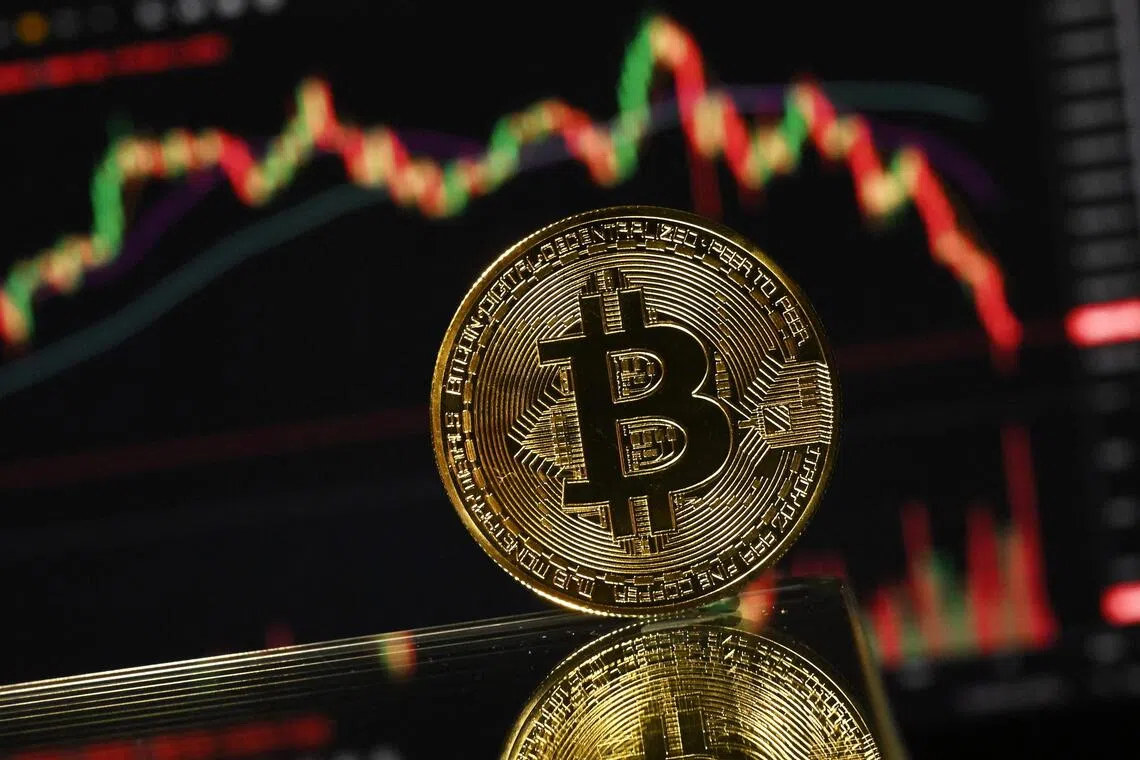Bitcoin weakness persists as crypto steadies after bruising week
Sign up now: Get ST's newsletters delivered to your inbox

After regaining some ground over the weekend, Bitcoin fell as much as 3.1 per cent to dip below US$86,000 on Nov 25, before paring the loss.
PHOTO: AFP
Follow topic:
- Bitcoin fell, trading near US$86,000 after a selloff, potentially its worst month since 2022, despite institutional adoption.
- Traders are buying downside protection, with put options at US$80,000 becoming popular. Bitcoin funding rates are now negative.
- Investors withdrew over US$3.5 billion from US Bitcoin ETFs. Short-term holders face high losses, needing more demand to recover.
AI generated
NEW YORK – Bitcoin began the week on the back foot following a prolonged sell-off that has put the token on track for its worst month since 2022.
After regaining some ground over the weekend, the original cryptocurrency fell as much as 3.1 per cent to dip below US$86,000 (S$112,000) on Nov 25, before paring the loss.
While that is higher than the Nov 21 lows of US$80,553, traders see little cause for celebration. The wider crypto market is in a pronounced slump despite surging institutional adoption and a series of policy wins pushed for by US President Donald Trump, who has embraced the industry.
“Early trading today is showing slight weakness, but the moves are fairly small and within normal variations,” said Ms Caroline Mauron, co-founder of Orbit Markets.
Bitcoin is likely to trade in the US$80,000 to US$90,000 range throughout the week, as the market looks for clues about the Federal Reserve’s upcoming rate decision, she added.
In the crypto options market, traders are building downside protection at lower levels, even with Bitcoin prices seeing a slight rebound in the last 24 hours.
Demand for put options at the strike of US$80,000 has surpassed those at US$85,000, becoming the most popular contracts, according to the Coinbase-owned crypto exchange Deribit.
Meanwhile, the Bitcoin funding rate – a key measure of crypto market sentiment – turned negative in the last few days, according to CryptoQuant, meaning there is more demand for bearish bets in the perpetual futures market than bullish positions. That figure had been persistently positive even amid the market rout in recent weeks. The flip points to signs of deepening slump in digital assets as more traders bet against the largest cryptocurrency.
Without a turnaround, November will become Bitcoin’s worst month since a string of corporate collapses rocked the crypto market in 2022, a wipe-out that culminated in the downfall of Sam Bankman-Fried’s FTX exchange.
Traders are watching US$85,200 as a key support level after last week’s breakdown, said Ms Rachael Lucas, analyst at BTC Markets.
“Technicals and macro headwinds are dominating over fundamentals right now, but history shows these liquidation flurries often precede bounces if no new shocks hit,” she said.
Despite a weekend rebound, Bitcoin remains about 30 per cent below its record high in October, and it is unclear how long the recovery will hold without stronger tailwinds. Open interest in perpetual futures has yet to bounce back, lingering 36 per cent below its October peak of US$94 billion.
Investors have withdrawn more than US$3.5 billion from a group of US-listed Bitcoin exchange-traded funds, vehicles that have emerged as a major driver of the token’s price since their debut. A sustained reversal of those outflows has yet to emerge.
“Unlike prior crashes driven primarily by retail speculation, this year’s downturn has unfolded amid substantial institutional participation, policy shifts and broader macroeconomic headwinds,” Deutsche Bank analysts wrote in a note on Nov 24.
A recovery may also be restrained by the pressure on investors who entered the market at higher levels. Realised losses among short-term holders – wallets that have held Bitcoin for less than 155 days – have climbed to US$630 million per day, the highest since the June 2022 meltdown, according to Glassnode.
“Such elevated loss realisation highlights the heavier top structure built between US$106,000 and US$118,000, far denser than previous cycle peaks,” analysts at Glassnode said in a research note.
“Either stronger demand must emerge to absorb distressed sellers, or the market will require a longer, deeper accumulation phase before regaining equilibrium.” BLOOMBERG

